[Ed. note – This is a joint review between Mitchell Oke and myself. My comments will be in black, and Mitchell’s will be in blue italics. Before reading this, you might want to first read Mitchell’s article “HTC Touch HD = Stands for Hot Damn!!” and my “HTC Touch HD Walk-Around and First Impressions” and “A Quick Tease: the HTC Touch HD and Nokia N85″]
It seems like it’s been ages since there was a Windows Mobile phone with a nearly 4″ screen. The last one I can remember was my much loved HTC Universal, and that was back in…early 2006, which seems like forever ago. Since then, the trend has been that mobile phones have smaller and smaller screens, even when those screens came with VGA or better resolutions. While this has been great for portability, it has not been good for people like me who wanted a larger screen for reading, looking at spreadsheets, or dealing with other on-screen negotiations.
With the introduction of touch interfaces on so many Windows Mobile phones over the last two years, I have felt that the one thing missing was a return of a 4” VGA or better screen. When I heard about the HTC Touch HD, a device technically only intended for the Asian and European markets, I decided it was probably the closest thing I was going to get.
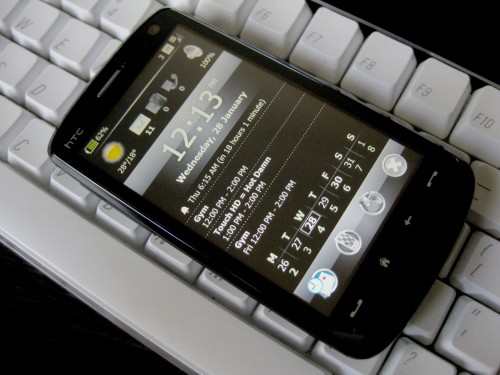
I’ve been looking forward to the Touch HD since I first read about it last year. With its massive WVGA, 800×480 display, sleek profile, minimalist yet stylish design and big battery, there definitely was a lot to get excited about. I have to admit I was also excited to see the HD picked up a conventional 3.5mm headphone jack, since if I was to buy one of these things, it would need to replace my beloved iPod Touch.
And I don’t know about your unit, but mine supported both UMTS 2100 and the American UMTS 850 😉
I believe that I probably got the same device you did. Since technically there no US version, HTC sent me the European / Asian version, which basically lacks US 3G. Since I don’t have 3G where I live and was well aware that the HD would not have it before I was sent the device, this was not a con for me. 🙂
I hate to do it, but I’m going to make a few comparisons to the iPhone. It can’t be ignored that the design of the Touch HD is rather similar to the iPhone. Power button on top? Check. Volume switches on the left? Check. Massive, bright, stunning, magnificent display on the front? Check.
I don’t think that there is any way to get around the fact that there are going to be direct comparisons to the iPhone made anytime someone is talking about a large-screened touch-based device, which definitely describes the HD.
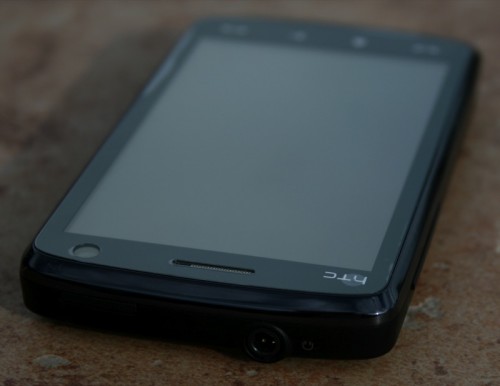
That said, the Touch HD a good looking handset. Unlike the Touch Diamond and Touch Pro, the HD is a single piece of plastic (yeah, unfortunately they didn’t copy the glass part) from top to the bottom, and that’s exactly the way it should be. With a split in it to separate the buttons, the design wouldn’t look anywhere near as good, and thankfully HTC recognised this.
I am a big fan of the HD’s appearance, and I really appreciate how they kept everything as clean and simple as possible. I will admit to sometimes wishing that there was a D-pad, however…
There were a few occasions where I thought about the lack of D-Pad, but to be honest it never really bothered me. Making some more of the buttons push-and-hold programmable would have been nice though.
Since we are already talking about hardware, might as well kick off there! The hardware is really what differentiates a Windows Mobile device. The Touch HD has the honour of being one of the few WM devices to sport an 800×480 resolution display, and I’ll say straight up this should no longer be an exception to the rule; all WM devices (and other devices too) should come with high-res displays like this.
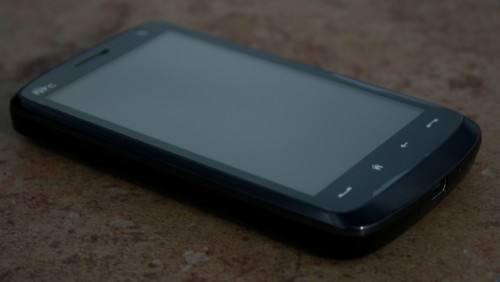
While many bemoaned Microsoft’s decision to make VGA devices display basically the same amount of information but at a higher DPI, it really is the best way to go. This results in super-sharp text and UI elements that make the user experience more enjoyable. By dumping the D-Pad and forgoing a thumboard (either side-slide or tacked on the bottom), HTC have managed to squeeze the biggest display possible into the HD’s sleek body. Many will whine that is it too big, too wide, too long. My advice is to buy another phone, because the HD’s display is worth it. Never have I felt the mobile browsing experience to be so good.
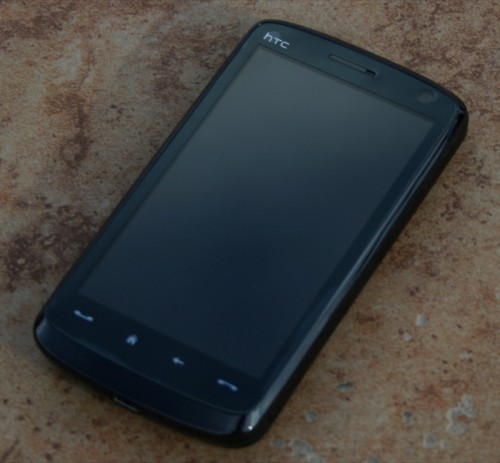
People may whine about the HD’s size, but as I pointed out before – it is only 4.4? long x 2.5? wide x 0.5? thick, and it weighs 5.2 ounces. So when compared that to the iPhone 3G, which is 4.5″ tall x 2.4″ wide x 0.48″ thick and weighs 4.8 ounces, you can quickly see that it is not really any bigger and it is certainly just as pocketable. Of course, the HD not only boasts a larger screen (3.8″ vs. 3.5″), but it also has the much higher screen resolution (480 x 800 vs. 480 x 320), so you are getting even more bang for your buck..
Absolutely, it’s definitely worth the extra size over other devices like the Diamond, and if people can be happy with the size of the iPhone, then they can with this too.
Desktop sites, the bane of many phones (although Opera’s Mini browser makes them usable), are for the most part perfectly rendered on the Touch HD. When in landscape mode, you have 800 horizontal pixels to work with, which is enough for many websites. 1024px width has become more common over the last few years, but the HD zooms the page accordingly. With good eyesight (lucky me :D), pages are readable when zoomed out.
Should you decide you don’t want glasses in the next few years, you can zoom in and the browser will reflow the text and images.
I have nothing but praise for using the Opera Browser on the HD. Granted, it obviously isn’t exactly the same as using Safari on an iPhone (much as using Internet Explorer versus Safari or Fire Fox might be on a desktop; they are just different), but it is surprisingly similar in terms of giving a rich and satisfying mobile browsing experience.
You should try out the latest beta version of Opera Mobile, v 9.5, it is quite a bit faster than the version that ships on the Touch HD. I grabbed it off xda-dev, and it is awesome!!
With it’s massive, high res screen and 3.5mm headphone jack, the HD looks like it could be a fantastic media playback device. While it’s good, there were a few issues I came across in my testing.
You see my benchmark for a good all-round media player is the iPod Touch. Sure, many will cry that it’s screen doesn’t have a high enough resolution or a large enough size, its capacity pales in comparison to many of the competition, and that it’s format support is woeful, but in my experience it just gets the job done, and does it damned well. There are definitely points for the HD on its screen resolution, but things start to waver when you try and push some high-res content onto it. I loaded up the latest version of CorePlayer, which has optimisations for the Touch HD’s hardware, but it started to fall apart pretty quickly. I transferred some videos I had converted for my iPod Touch, and they wouldn’t play fluidly. They’d be ok for a bit, then there would be massive lag and dropped frames, and then it would more or less recover. Some might say I should use lower quality files, but this thing really needs to be able to handle files nearing it’s screen res, heck these are quite a bit higher-res than the screen on the Touch and it plays them no problem!
I noticed stuttering and pixelization when watching video on the HD. With that said, I have to admit that for whatever reason I just didn’t watch much video on the device at all. It’s almost a psychological thing, I think, because I purchased the first two seasons of Life from iTunes, and I watch that on my iPhone any time I get a chance. Since that show won’t play on the HD, I just didn’t think of the HD as a video player the same way I do my iPhone.
It certainly can’t take the higher bitrate files the iPhone can, partly due to the high-resolution display it has to pump the video out to. CorePlayer really is a must on this device, especially since it’s getting more and more optimised for the hardware.
Music playback fared better, pairing up perfectly with the 3.5mm jack. Using either HTC’s bundled media player or the standard Windows Media Player, audio quality was good and I didn’t experience any of the stuttering problems I’ve seen mentioned on some forums. With the bundled 8GB microSD card I could really see the Touch HD replacing my music player, and with some further optimisation it would be a great video player as well.
I was quite impressed with music playback on the HD; it worked fine and it sounded good. Being able to use my favorite headphones with the device made the experience that much better.
The biggest problem I found with the HD was text input. As a massive fan and user of the Nokia E71, I’ve become accustomed to having a brilliant, tactile thumboard to mash away on for sending SMSes, emails and instant messaging. The HD is bundled with the same large-keyed on-screen keyboard as the Diamond, and it is still poor in it’s implementation. Unlike the iPhone, it doesn’t correct your mistakes on the fly, which makes input slow and frustrating as you have to keep backing up to fix typos.
I expected to dislike the HD’s keyboard more than I did; with a bit of practice I was happily tapping out messages using the ABC QWERTY version. Granted, not including some sort of spell check or automatic mistake correction was a serious oversight – especially for those used to the (usually) helpful feature on the iPhone.
Of course, using the T9 QWERTY version did provide a bit of intuitive input, but I did not find myself using this keyboard as often; I simply didn’t like it as much.
Making the keys a tad taller might have made things a little easier, at the expense of screen real estate (though the HD is hardly lacking in that department), but it still wouldn’t be anywhere near as good as the iPhone’s keyboard, or a phone with a hardware keypad.
I don’t think that’s entirely fair, and here’s why: it takes time to get used to anything new, and that’s exactly what I needed with the HD’s keyboard – time to get used to it, and time to accept that it wasn’t going to act like the iPhones. As for not being as good as a phone with a hardware keyboard, that’s the trade-off of getting a thin device like this. If you really want a hardware keyboard, then you’ll have to get the Touch Pro, or wait for the recently announced HTC Touch Pro 2.
I tried and tried for 3 weeks to get it, and while my text entry improved, it still felt slow and awkward. Personally, I HATED the T9 mode, it never seemed to get it right for me.
I agree with you on the T9 mode; it was not as intuitive or helpful as I wanted it to be. That’s why I stuck with the regular keyboard.
The poor auto-correction was the main problem with it for me, hence why I think they iPhone’s keyboard (with its better auto-correction) is better. Still doesn’t hold a candle to my E71 though 😉
Well yeah! With its dedicated keyboard! 😉
Under the hood, the HD is very similar to the Touch Diamond. While the HD has a bit more internal memory (excluding the Diamonds 4GB internal storage area), it shares the Diamonds 528Mhz Qualcomm processor, and comes packaged with all the radios a good smartphone should these days (HSDPA, WiFi, Bluetooth, GPS, FM, Morse Code). None of this should really be a surprise considering the Touch HD’s staggering price tag. The question I’ve been trying to answer over the last two weeks is whether it’s worth its AU$1500 price tag. People thought the Shift was expensive…
Oh, there is no disputing the fact that the Touch HD is pricey; in the US you can expect to pay about $700 (ordered from Expansys), and unless a major carrier decides to offer a US version there won’t be any subsidies.
I guess we should talk about how it fairs as a phone. It’s easy to forget today’s smartphones are actually mobile phones underneath, since there is so much functionality bolted to them. Problem is this functionality can mush together and make the phone a pain to use.
This has been a major issue for me in the past. I would get a really great, fully featured PDA that didn’t function very well as a phone. For a while, it actually drove me to use a dumb phone (:cough: the Vertus), because I wanted a good phone.
Hehe, I had a short stint with a Nokia 8800 Arte (what is it about moving from smartphones to Nokia’s super-high end fashion phones?) because it was so good as a phone, and so small. It was good…but I’m back to smartphones now 😛
Ditto. Maybe we just needed the “break” so we could appreciate smartphones again. 😉
I found the HD to be really good to use as a phone, since it is quite responsive, doesn’t drop calls and has excellent signal sensitivity. Handy features like the contact search in the dialer screen (start typing a name from your contacts list using the number pad and it will filter till you find the one you want) make it really easy to initiate calls quickly. Sliding the stylus out while in a call opens the Notes application. It’s feature that has appeared on HTC devices before, but still a good one.
I was pleasantly surprised by the HD’s performance as a phone; not only was signal strength comparable to the Nokia N85 I’ve also been using, it didn’t drop calls or do any of the other deal-breakers that have plagued various smartphones I’ve tested in the past. The added bonus of the huge screen for GPS and reading made carrying the HD a pleasure.
Agreed, at last HTC’s phones have decent radios in them, so they can hang out in the low-signal areas of town without getting lost. On the signal front it has been every bit as good as my Nokia N95 8GB and E71, which is saying something.
My biggest concern before receiving the Touch HD was how it’s battery would fare being tortured by half a dozen radios and a massive WVGA display. To be honest I was stunned at how good the battery life on the HD was over the month I had it. Even with heavy use, which for me is several hours of web surfing, Exchange push email on, Messenger signed in and being used frequently, a fair few calls and a couple of pictures per day, it would still last late into the evening. Not once during the testing period did I get a battery warning, even after a hard days use from 7am up to 11pm. If fact one evening I forgot to charge it (plugged in the cord, but it wasn’t connected to the wall :-P), and I still managed to get through till 3pm the next day before I put it on charge.
I was also impressed with the HD’s battery life. Granted, I wasn’t using Exchange, but I was pulling in my email several times an hour, updating my calendar and contacts through Plaxo several times a day, reading eBooks…
…using GPS and Google Maps (as well as Google Latitude), and using countless other applications that did or didn’t involve the radios…and the HD never missed a beat!
One of the last things that I want to talk about is the HTC TouchFLO interface and how it performs as compared to other touch based devices. So first, a little background. The HD’s screen is resistive, which means that it can respond to a tap from a fingernail, finger, stylus, or other object; compare this to an iPhone’s screen which is capacitive, meaning that it will only respond to a finger’s touch or a special capacitive pen. You can read more on what the differences mean here, but the point is that if you are used to the iPhone, going to the HD will be a little bit different.
I would have preferred a capacitive, it just works soooo much better on devices that are more likely to be prodded by fingers instead of stylii. That said, the screen on the HD was close to the sensitivity of a capacitive screen, so it does give the best of both words. If for instance you are a fan of transcriber or any other kind of handwriting recognition, the HD’s enormous screen is a joy to write on.
The main difference that I found between the HD’s screen and the iPhone’s, was that I needed to be deliberate with my finger swipes and taps on the HD, especially in the beginning; after a few days of using the HD, I no longer had to really think about it. Granted, there are some times when a capacitive screen would be much sweeter, especially when swiping the icons along the bottom of the HTC TouchFLO screen, but for the most part, it really wasn’t that big of a deal.
An additional benefit, if you want to call it that, is when wearing gloves, a resistive screen will still respond, whereas a capacitive screen won’t. Since we are coming out of winter here in the US, this was an HD screen trait that I appreciated.
Good point!! Though we’ve been having 40C days here recently, so gloves weren’t laid out when I left for work of a morning 😉
The main thing to consider here is that since the screen is so large, there is much more room for finger taps and movements, so unlike some of the smaller-screened TouchFLO device (like the HTC Diamond for instance), the screen never felt crowded or un-navigateable to me.
Completely agree, the size of the display, and the way it handled web browsing really made me think about dumping my E71 for the first time since I bought it last year.
Overall I’d have to say that for what it is, the HTC Touch HD is easily the best Windows Mobile device I have ever used. Granted, I will always wish that HTC would give in to my desires and update the HTC Universal, but since that doesn’t seem to be happening, I have to make do. While I would love to have this exact device with a Universal’s flexible and foldable cover-keyboard attached, the HD’s slim form factor and very usable on-screen keyboard have made it an absolute joy to use – both as a phone and as a fully functional PDA.
HTC really have taken WM to a new level with the HD. By giving it a svelte form factor, an understated and classy look, most of the radios available, excellent battery life and that gorgeous screen, they have created something simply fantastic. With some tweaks to the text entry software, I wouldn’t hesitate to buy one, bank balance permitting 😉

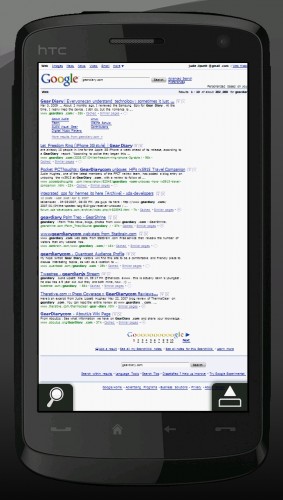
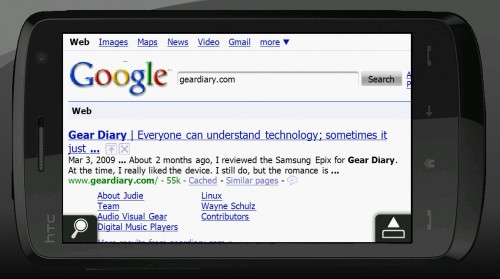
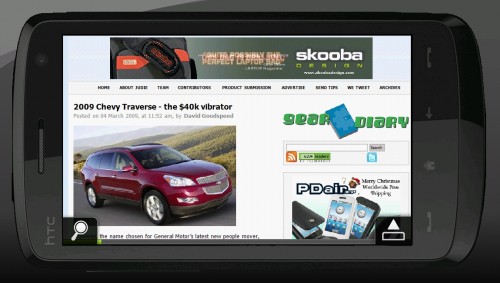
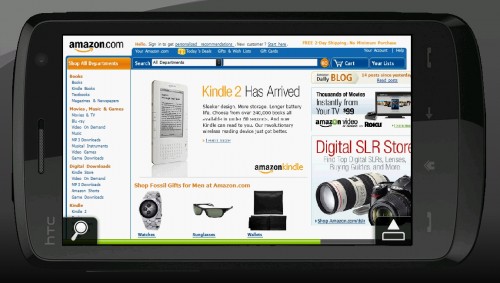

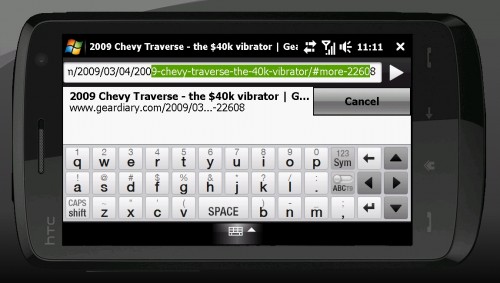
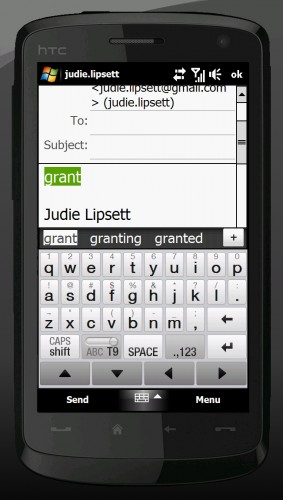
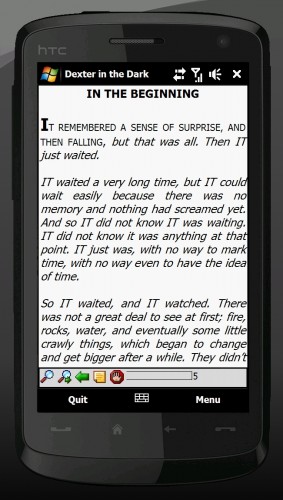
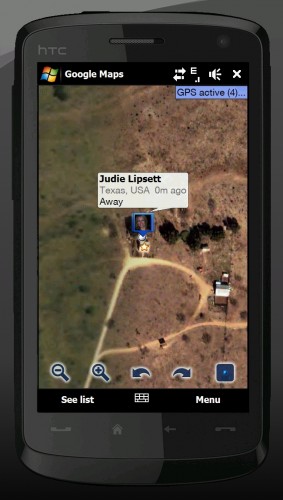
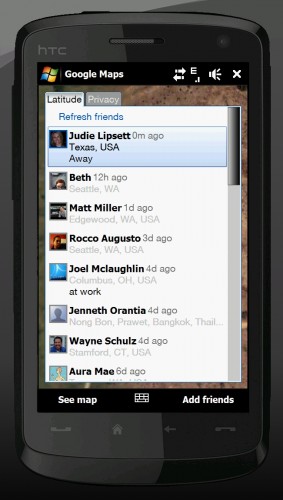
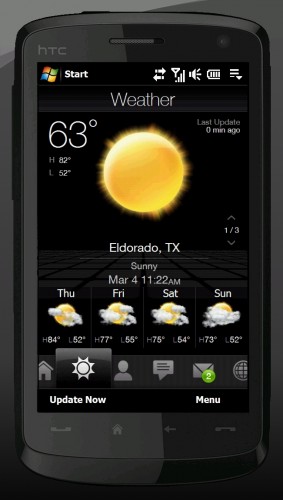



















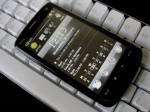
Touch HD review is up! 🙂 http://is.gd/mgxF
Great review guys. I remember when we all wanted PocketPC's with a large screen. This looks like a pretty good phone even with the flaws.
WoW! Sounds like quite the phone despite the STAGGERING cost.. I think, for the same price I can almost buy 2 new HTC Shifts now.. 🙂
Hmmmm. Now that Verizon is about to release the original Diamond we have an interesting choice. My main objection to the Diamond was the lack of a card slot. That’s now moot. Bit concerned about the touch on the 2.8″ keyboard. If we get it now in 2 years can upgrade again (if rules don’t change). Otherwise its 6 to 9 months for the Diamond 2 or Whitestone (HD successor) in the US. From the review, sounds like i should keep the ole Motorola Q for a while…. I'm hoping they release these subsidized at the US $200 price point to really compete with iPhone. BTW – great review guys. Suggestions?
My Advice: if you can wait, wait a little while longer. I think you would have a steeper period of adjustment going from the Motorola Q's candybar form factor with always available keyboard to a capacitive screen's virtual keyboard.
Even though the eye candy of the larger screen and updated operating system would almost make up for it, I think when you were answering texts or email you would regret the decision – unless you are really ready for a change.
Have you seen this?
Mmmmmm…Maple! 😉
Okay,
Further clarification.
It appears there really are 2 versions of the Touch HD out there:
T8282 – Europe/Asia: 900/2100 MHz
T8285 – Australia (only Telstra) / US (Most Networks) : 850/2100 Mhz
So that would explain why Mitchell's unit supported the 850 UMTS band. So U.S. buyers should look for the T8285!
Good catch Chris! I didn't realize that Australia's Telstra had their own version with specs that would make it compatible with US 3G. Verrry Interesting! 😀
Judie. Thanx so much for your advice. The Maple is much like the Q. The main reason to upgrade is more screen real estate…. so i do want a touch phone when the technology is mature.
Dont forget bluetooth stereo h2dh. Some of us dont like wires I do like that it has a 3.5 jack hook up to my car home stereo or good headphones but riding a bike jogging or just working around the house stereo bluetooth with no wires is the way to go for stereo